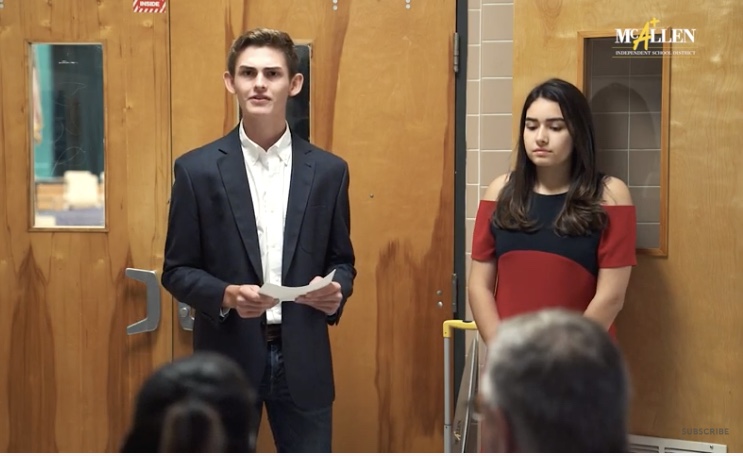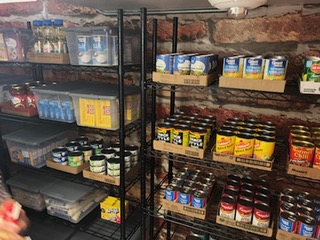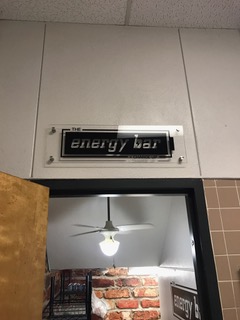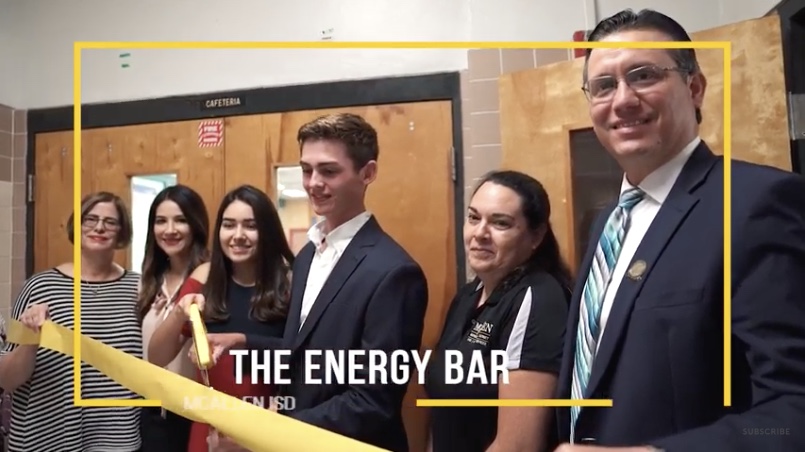Share On Social!
High-schoolers Samantha Almaraz and Pablo Ramirez see many classmates who struggle with hunger and poverty in the 85% Latino border town of McAllen, Texas.
They wanted to help.
So Samantha and Pablo, 10th-graders at Lamar Academy, started a school food pantry by working with their parents, school leaders, and using the Salud America! “School Food Pantry Action Pack” as a guide for their efforts.

With their pantry, called the Energy Bar, they store leftover food from the cafeteria and distribute it to hungry students.
“We’re surrounded by people who are hungry and that don’t get food,” said Samantha, who with Pablo is in the International Baccalaureate program at Lamar in McAllen ISD. “They tell us, ‘I don’t have food waiting for me at home.’”
The Energy Bar is not only popular─it’s expanding beyond what they first imagined.
Tackling Food Insecurity on the Border
U.S. Latinos face high of poverty and food swamps. They also face food insecurity, which is living without reliable access to enough affordable, nutritious food.

In Texas, the food insecurity rate is 14.3%.
In Hidalgo County, home to McAllen, it’s worse. The child food insecurity rate is 28%.
McAllen ISD participates in four nutrition programs. With these, it can provide about 6.9 million meals per school year for free to students.
Still, at Lamar, where Samantha and Pablo attend, up to 80% of students are economically disadvantaged and food insecure.
Samantha and Pablo didn’t know how they could make a difference.
That is, until they learned about Senate Bill 725.
New Law Allows School Food Pantries
A few years ago, Texas State Rep. Diego Bernal toured San Antonio schools. He learned about rampant food waste in the midst of deep poverty and food insecurity.
It led him to champion Senate Bill 725, The Student Fairness in Feeding Act.
Essentially, the law allows Texas schools to become their own food pantries.
A school can name a campus designee, such as a teacher, counselor or PTA member, as the designee of a third-party nonprofit, allowing the school to donate, receive, store, and redistribute the leftover food on campus at any time.
Samantha and Pablo learned about this law.
They decided to try and start a school food pantry at Lamar.
The Start of ‘The Energy Bar’ at Lamar
Samantha and Pablo got help from their parents to push for a school food pantry.

They also used the materials in the Salud America! “School Food Pantry Action Pack.” The Pack is a free guide to help parents and school leaders talk to decision-makers, work through logistics, and start a school food pantry. The Pack was created by Dr. Amelie G. Ramirez, director of Salud America! at UT Health San Antonio, with input from Jenny Arredondo, nutrition director at San Antonio ISD.
At Lamar, Samantha and Pablo got buy-in from school leaders pretty fast. They helped conduct the planning and logistics for the pantry.
They named it the Energy Bar.
The pantry is housed in what was once an old storage closet for science equipment. Now the area has a refrigerator filled with fruits, granola bars, milk, juice, and soups. Students can access the Energy Bar at all times of the day.
They placed three portable bins at the cafeteria during breakfast and lunch, where students can drop in certain unopened items like milk or juice boxes, apples, and granola bars they do not want to eat. Students can grab from the bins if they are still hungry. Whatever is leftover heads to the Energy Bar.
“We redistribute out [leftover food] that students do not want,” Samantha said.
Irene Ramirez, Pablo’s mother, and the students also expanded the pantry to a new level by accepting donations of deodorant, shampoo, toothpaste, etc.
They even conduct fundraisers to buy more canned goods and basic necessities to stock in the pantry.
“We just wanted to find a way to go above [with food and toiletries] and beyond, and help those in need,” Irene Ramirez said.
Energy Bar a Hit with Students
Students and school leaders say the pantry has helped many students.
“It’s been a complete success, and the way we measure our success is by seeing that every day that food goes and we have to restock,” said Dora Almaraz, Samantha’s mother. “The need is there and we see it.”

Eventually, Samantha and Pablo would like McAllen school leaders to take Lamar’s school food pantry as a model to open a pantry at every campus.
“We’re hoping the district will become a zero-waste district and be able to provide all their students with necessary goods,” Pablo said.
Start a School Food Pantry at Your School!
You can be like Samantha and Pablo in McAllen.
Or like Jenny Arredondo, the nutrition leader at San Antonio who helped start more than a dozen school food pantries at district campuses.
You can start by using the four-step Salud America! School Food Pantry Action Pack:
- Start the Conversation. Use the model emails and talking points to talk to decision-makers about the need for School Food Pantries.
- Build Support. Use the model letter campaign, handout, emails, and presentation to build support for your pantry.
- Plan and Implement a Pantry. Use Salud America!‘s “Quick Guide” and real templates from San Antonio ISD—which implemented 10 School Food Pantries—to craft your own.
- Promote Your Pantry. Use the printable signs and shareable social media graphics to alert students, parents, and the community to your big change.
Why do this?
Because research shows children who go to school hungry are more likely to have poorer grades and mental health issues. This makes it hard to succeed academically, socially, and emotionally.
So help kids at your school with a school food pantry today!
By The Numbers
142
Percent
Expected rise in Latino cancer cases in coming years
This success story was produced by Salud America! with support from the Robert Wood Johnson Foundation.
The stories are intended for educational and informative purposes. References to specific policymakers, individuals, schools, policies, or companies have been included solely to advance these purposes and do not constitute an endorsement, sponsorship, or recommendation. Stories are based on and told by real community members and are the opinions and views of the individuals whose stories are told. Organization and activities described were not supported by Salud America! or the Robert Wood Johnson Foundation and do not necessarily represent the views of Salud America! or the Robert Wood Johnson Foundation.



